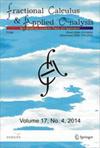分数阶拉普拉斯热方程的反系数问题
IF 2.9
2区 数学
Q1 MATHEMATICS
引用次数: 0
摘要
本文研究了分数阶热方程中时间相关系数和未知源函数的反演问题。我们的方法表明,在一个观测点上只有一组数据确保了逆问题的弱解的存在。此外,如果在观测点上有一个额外的基准,它会导致一个特定的时变源系数公式。此外,我们还研究了涉及分数阶热方程非局部数据的反问题。本文章由计算机程序翻译,如有差异,请以英文原文为准。
Inverse coefficient problems for the heat equation with fractional Laplacian
In the present paper, we study inverse problems related to determining the time-dependent coefficient and unknown source function of fractional heat equations. Our approach shows that having just one set of data at an observation point ensures the existence of a weak solution for the inverse problem. Furthermore, if there is an additional datum at the observation point, it leads to a specific formula for the time-dependent source coefficient. Moreover, we investigate inverse problems involving non-local data of the fractional heat equation.
求助全文
通过发布文献求助,成功后即可免费获取论文全文。
去求助
来源期刊

Fractional Calculus and Applied Analysis
MATHEMATICS, APPLIED-MATHEMATICS, INTERDISCIPLINARY APPLICATIONS
CiteScore
4.70
自引率
16.70%
发文量
101
期刊介绍:
Fractional Calculus and Applied Analysis (FCAA, abbreviated in the World databases as Fract. Calc. Appl. Anal. or FRACT CALC APPL ANAL) is a specialized international journal for theory and applications of an important branch of Mathematical Analysis (Calculus) where differentiations and integrations can be of arbitrary non-integer order. The high standards of its contents are guaranteed by the prominent members of Editorial Board and the expertise of invited external reviewers, and proven by the recently achieved high values of impact factor (JIF) and impact rang (SJR), launching the journal to top places of the ranking lists of Thomson Reuters and Scopus.
 求助内容:
求助内容: 应助结果提醒方式:
应助结果提醒方式:


